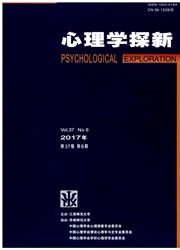

 中文摘要:
中文摘要:
该实验采用Bijlstra等运用的比较任务实验范式,通过E-prime2.0编程,来探讨社会类别对表情识别的影响究竟是通过评价联结路径还是刻板印象路径起作用。85名被试随机分配到比较情境中,包括一个双效价比较情境(高兴对生气或高兴对伤心)和一个单效价比较情境(生气对伤心),让被试在规定的时间内对他们所看到的两种面部表情图片进行识别和分类。结果发现:(1)在双效价情境中,和消极情绪比较而言,被试更快识别积极情绪,尤其是女性目标面孔上所表现的积极情绪;(2)在双效价情境下,被试更快识别男性面孔上的伤心表情,而在单效价情境中,被试更快识别女性面孔上的伤心表情;(3)在双效价和单效价情境中,对生气的反应没有差别。研究表明当表情的效价在发生作用的时候,表情识别主要受到评价联结路径的影响;当表情效价相同的时候,刻板印象路径会影响表情的识别。
 英文摘要:
英文摘要:
By adopting comparative context experimental paradigm used by Bijlstra et al( 2010) and programming with E- prime2. 0,this study explored whether social categorization processes influence emotion recognition by evaluative associations or stereotype associations. 85 subjects were randomly assigned to comparative context conditions including a dual- valence comparative context condition in which participants categorized happy versus angry,or happy versus sad expressions and a single- valence comparative context condition in which anger versus sadness were categorized. Subjects were asked to identify and classify the two emotional expressions which they saw within the stipulated time. The results were as follows:( 1) In the dual- valence comparative context condition,compared to negative emotions,subjects identified positive emotions faster,especially the positive emotions displayed on female targets.( 2) In the dual- valence comparative context condition,subjects identified sad expression displayed on man targets faster,whereas in the single- valence comparative context condition,subjects identified sad expression displayed on female targets faster.( 3) On the response to angry expression,there was no difference between the dual- valence and single- valence comparative context conditions. The results indicated when the valence of emotional expressions does come into play,that is to say,the valences are different,evaluative associations influence the emotion recognition. When the valence of emotional expressions is the same,recognition facilitation occurs for stereotypically associated discrete emotional expressions.
 同期刊论文项目
同期刊论文项目
 同项目期刊论文
同项目期刊论文
 期刊信息
期刊信息
